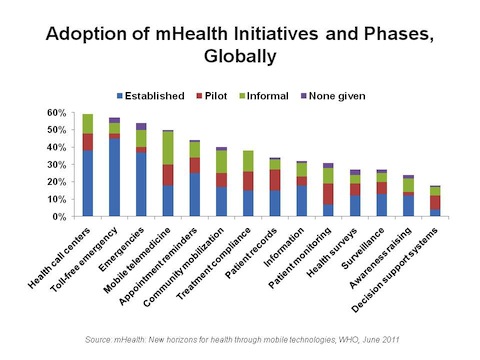More than 85 percent of the world’s population is covered by wireless phone signals. The global proliferation of wireless phones provides a technology platform to move health services to people — broadly referred to as ”mobile health” or “mhealth.” mHealth: New Horizons for health through mobile technologies, the World Health Organization’s (WHO’s) second report on mobile health, summarizes a survey of mobile health developments around the world, published in June 2011 based on survey data from 2009 collected in 114 nations.
WHO learned that mHealth is most easily deployed into health applications where voice communication via traditional phone networks has been used. Thus, in important applications like surveillance and decision support, mHealth is less likely to be established because these functions require more advanced capabilities and technology infrastructure.
The survey evaluated mHealth services in 14 categories, as shown in the chart. These include health call centres, emergency toll-free phone services, emergencies and disasters, mobile telemedicine, appointment reminders, community mobilization and health promotion, treatment compliance, mobile patient records, information access, patient monitoring, health surveys and data collection, surveillance, health awareness raising, and decision support.
The most prevalent of these services are toll-free emergency applications, mobile health call centres and emergency services, and mobile telemedicine, all available in over 50 percent of WHO member states. In addition, mHealth-based appointment reminders are available in a plurality of nations.
The most popularly piloted mHealth programs include patient monitoring, treatment compliance, mobile telemedicine, and patient records.
For Sarasohn-Kahn's analysis head over to Health Populi for the rest of this post.
















